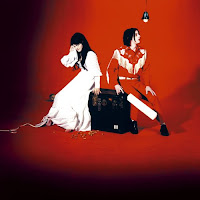The album was recorded on 8 track tape and pre-1960s recording gear, as writer/producer/guitarist Jack White refused to use a digital audio workstation at any time during the writing or recording of the album.
The Song
“Seven Nation Army” is about all about the riff that the song is built on. In fact, it’s one of the few songs that has an instrumental chorus that’s built upon the central riff of the song. The form looks like this:
Intro ➞ verse ➞ turnaround ➞ chorus ➞ intro ➞ verse ➞
turnaround ➞ chorus (2X) ➞ intro ➞ verse ➞ turnaround ➞ chorus ➞ end
The form is a cross between a normal 16 bar pop music verse and 12 bar blues. It’s 16 bars long, but there’s an two additional bar turnaround that leads into the instrumental chorus.
The lyrics only state the title once during the song, and reflect how The White Stripes were dealing with their then new-found popularity. “Seven Nation Army” actually refers to writer Jack White’s name for the Salvation Army when he was kid. Considering that the song is based over a repeating riff, the melody is quite good in that it actually develops during the second half of the verse.
The Arrangement
The arrangement for “Seven Nation Army” is fairly simple but very effective. The song begins with the bass sound (actually a 1950s Kay 6 string acoustic/electric guitar through a Digitech Whammy pedal set an octave below standard tuning) that’s joined by the kick, floor tom and hat after it plays twice. After another two times through the riff, the verse vocal enters. Half-way through the verse the snare enters. During the two bar turnaround, a big sounding guitar enters that’s doubled, which continues into the first chorus.
The second verse and turnaround are identical to the first, but the second chorus is joined by a slide guitar and is placed twice as long. Once again the next intro, verse and turnaround are identical, with the exception of some guitar feedback that hangs over onto the intro. The last chorus is identical to the first one, as the slide guitar is not present and it’s the same length. The song has a hard ending, with an additional reprise from what sounds like a previous take.
Arrangement Elements
- The Foundation: drums and bass guitar
- The Rhythm: drums
- The Pad: none
- The Lead: lead vocal in verse, doubled electric guitar in chorus
- The Fills: none
The Sound
“Seven Nation Army” was recording on 8 track analog tape in a studio where nothing was newer than from 1963, hence the vintage sound. The song as a number of interesting sonic quirks. First of all, the guitar playing the bass is panned to the left and you can hear a bit of the amp reverb boing if you listen closely. Then the drums are recorded in mono, which is extremely unusual for this day and age but quite the norm back in the days when 8 tracks was the maximum available. Finally, the vocals are somewhat distorted, but you get the feeling that’s on purpose rather than some gear anomaly or poor technique.
Of course, everything is dry as a bone, and whatever is panned to the right side is more of a ghost double until the very last chord of the song.
The Production
Jack White is a throwback to a previous time in many ways, and his production sense certainly proves that. From the concept of recording on analog and limiting the band to only 8 tracks, to the sparse arrangement and simple song form, “Seven Nation Army” could well have been made in the 60’s, it’s so retro. That said, what is retro to some is cutting edge to others, and the production of “Seven Nation Army” turned out to be a lasting hit that continues to echo around the world.
----------------------------------
You should follow me on Twitter for daily news and updates on production and the music business.
Don't forget to check out my Music 3.0 blog for tips and tricks on navigating social media and the new music business.



2 comments:
Thanks for posting this one. Days of Future or Past, at least there has been something "sonically great" that received lots of radio airplay within the last 10 years. With most everything else on major radio stations although the songs may have unique textures and intriguing lyrics, the dynamics are so squelched I'm just bored to death; except for this one. Of course, I'm "not advocating only one way to record, mix,etc ".... definitely not... only that my ears unusually perk up and this music feels like fun.
Great analysis!
Post a Comment